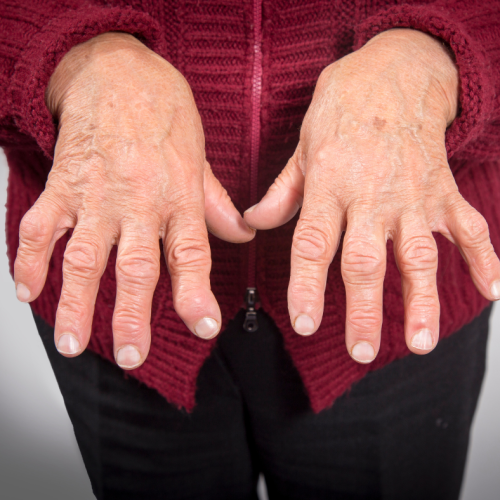Osteoarthritis
Osteoarthritis, also known as degenerative joint disease (DJD), is the most common type of arthritis. Osteoarthritis occurs more frequently with age. The changes in osteoarthritis usually occur slowly over many years, although there are occasional exceptions. Inflammation and injury to the joint cause bony changes, deterioration of tendons and ligaments, and breakdown of cartilage, resulting in pain, swelling, and deformity of the joint.
There are two main types of osteoarthritis
Primary – Most common, generalized, primarily affects the fingers, thumbs, spine, hips, knees, and the great (big) toes.

Secondary – Occurs with a pre-existing joint abnormality, such as repetitive or sports-related injury or trauma. Or pre-existing conditions including inflammatory arthritis, such as rheumatoid arthritis, psoriasis, or gout; infectious arthritis; genetic joint disease, such as Ehlers-Danlos (also known as hypermobility or “double joint”); congenital joint disease; or metabolic joint disease.
Symptoms of osteoarthritis
Osteoarthritis symptoms often develop slowly and worsen over time. Signs and symptoms of osteoarthritis include:
- Pain -Affected joints might hurt during or after movement.
- Stiffness – Joint stiffness might be most noticeable upon awakening or after being inactive.
- Tenderness – Your joint might feel tender when you apply light pressure to or near it.
- Loss of flexibility – You might not be able to move your joint through its full range of motion.
- Grating sensation – You might feel a grating sensation when you use the joint, and you might hear popping or crackling.
- Bone spurs – These extra bits of bone, which feel like hard lumps, can form around the affected joint.
- Swelling – This might be caused by soft tissue inflammation around the joint.
Cause of osteoarthritis
Osteoarthritis occurs when the cartilage that cushions the ends of the bones in your joints gradually breaks down. Cartilage is a firm, slippery tissue that allows joints to move almost frictionless.
When cartilage wears away completely, bone eventually rubs against bone.
Osteoarthritis is often referred to as a wear-and-tear disease. But in addition to cartilage breakdown, osteoarthritis affects the entire joint. It causes changes to the bone and deterioration of the connective tissue that holds the joint together and attaches the muscles to the bone. It also causes inflammation of the joint lining.
Treatment for osteoarthritis
Osteoarthritis can’t be reversed, but treatments can reduce pain and help you move better.
Therapy
- Physiotherapy – A physiotherapist can show you exercises to strengthen the muscles around your joint, increase your mobility, flexibility and relieve pain. Regular gentle exercise that you do yourself, such as swimming or walking, can be just as effective.
- Occupational therapy – An occupational therapist can help you find ways to do everyday tasks without putting extra stress on your already painful joint. For example, a toothbrush with a large handle might make brushing your teeth easier if you have osteoarthritis in your hands. A bench seat in the shower could ease the pain of standing if you suffer from knee osteoarthritis.
- Transcutaneous electrical nerve stimulation (TENS) – This uses a low-voltage electrical current to relieve pain. It provides short-term relief for some people with knee and hip osteoarthritis.
Medications
Medications that can help relieve osteoarthritis symptoms, primarily pain, include:
- Pain killers
- Anti-inflammatory drugs
- Anti-depressants
Any over-the-counter medications you take should first be discussed with your doctor. Medications may have side effects and should be taken as prescribed.
Surgical and other procedures
If conservative treatments don’t help, you might want to consider procedures such as:
- Cortisone injections – Injections around the joint may relieve pain for a few weeks.
- Lubrication injections – Injections of hyaluronic acid might relieve pain by providing some cushioning in your knee.
- Realigning bones – If osteoarthritis has damaged one side of your knee more than the other, an osteotomy (remove or add a wedge of bone) might be helpful. This shifts your body weight away from the worn-out part of your knee.
- Joint replacement – In joint replacement surgery, your surgeon removes your damaged joint surfaces and replaces them with plastic and metal parts.
Treatment at A7 Health for Osteoarthritis:
Get Physiotherapy – Book an appointment with a Physiotherapist at A7 Health who will assess you in a 45 minute consultation and provide treatment alongside a treatment plan to reduce joint pain and improve flexibility. Some of the treatments include:
- Heat therapy.
- Mobility exercises on any stiff joints to increase range of motion and flexibility.
- Massage to relieve pain, increase blood flow and reduce swelling.
- Strengthening exercises muscles around affected joints.
- Techniques to improve dexterity and make daily activities less painful.
